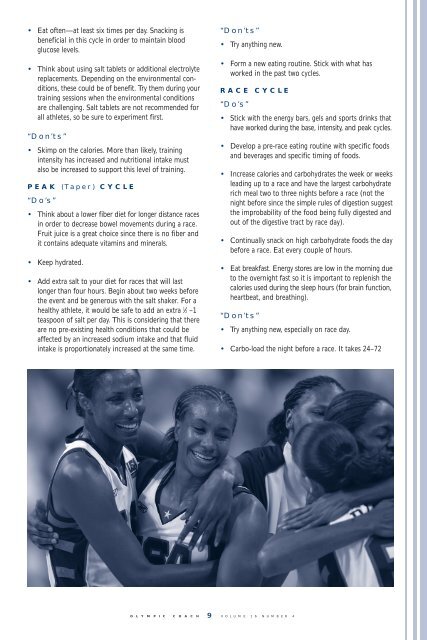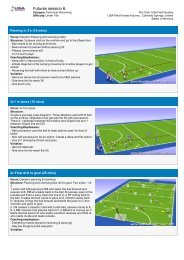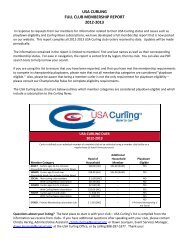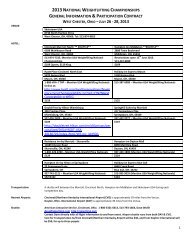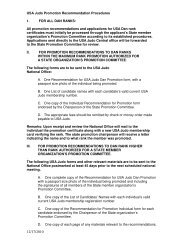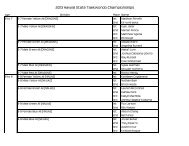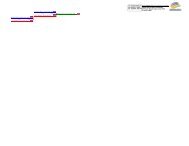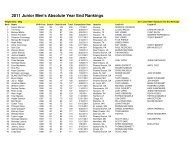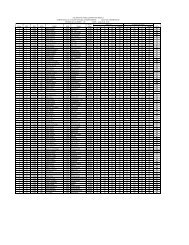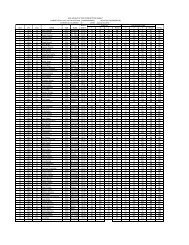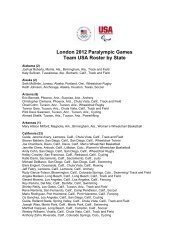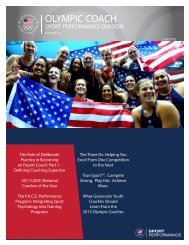OLYMPIC COACH - United States Olympic Committee
OLYMPIC COACH - United States Olympic Committee
OLYMPIC COACH - United States Olympic Committee
You also want an ePaper? Increase the reach of your titles
YUMPU automatically turns print PDFs into web optimized ePapers that Google loves.
• Eat often—at least six times per day. Snacking is<br />
beneficial in this cycle in order to maintain blood<br />
glucose levels.<br />
• Think about using salt tablets or additional electrolyte<br />
replacements. Depending on the environmental conditions,<br />
these could be of benefit. Try them during your<br />
training sessions when the environmental conditions<br />
are challenging. Salt tablets are not recommended for<br />
all athletes, so be sure to experiment first.<br />
“Don’ts”<br />
• Skimp on the calories. More than likely, training<br />
intensity has increased and nutritional intake must<br />
also be increased to support this level of training.<br />
PEAK (Taper) CYCLE<br />
“Do’s”<br />
• Think about a lower fiber diet for longer distance races<br />
in order to decrease bowel movements during a race.<br />
Fruit juice is a great choice since there is no fiber and<br />
it contains adequate vitamins and minerals.<br />
• Keep hydrated.<br />
• Add extra salt to your diet for races that will last<br />
longer than four hours. Begin about two weeks before<br />
the event and be generous with the salt shaker. For a<br />
healthy athlete, it would be safe to add an extra 1 ⁄2 –1<br />
teaspoon of salt per day. This is considering that there<br />
are no pre-existing health conditions that could be<br />
affected by an increased sodium intake and that fluid<br />
intake is proportionately increased at the same time.<br />
“Don’ts”<br />
• Try anything new.<br />
• Form a new eating routine. Stick with what has<br />
worked in the past two cycles.<br />
RACE CYCLE<br />
“Do’s”<br />
• Stick with the energy bars, gels and sports drinks that<br />
have worked during the base, intensity, and peak cycles.<br />
• Develop a pre-race eating routine with specific foods<br />
and beverages and specific timing of foods.<br />
• Increase calories and carbohydrates the week or weeks<br />
leading up to a race and have the largest carbohydrate<br />
rich meal two to three nights before a race (not the<br />
night before since the simple rules of digestion suggest<br />
the improbability of the food being fully digested and<br />
out of the digestive tract by race day).<br />
• Continually snack on high carbohydrate foods the day<br />
before a race. Eat every couple of hours.<br />
• Eat breakfast. Energy stores are low in the morning due<br />
to the overnight fast so it is important to replenish the<br />
calories used during the sleep hours (for brain function,<br />
heartbeat, and breathing).<br />
“Don’ts”<br />
• Try anything new, especially on race day.<br />
O L Y M P I C C O A C H 9 VOLUME 16 NUMBER 4<br />
• Carbo-load the night before a race. It takes 24–72


